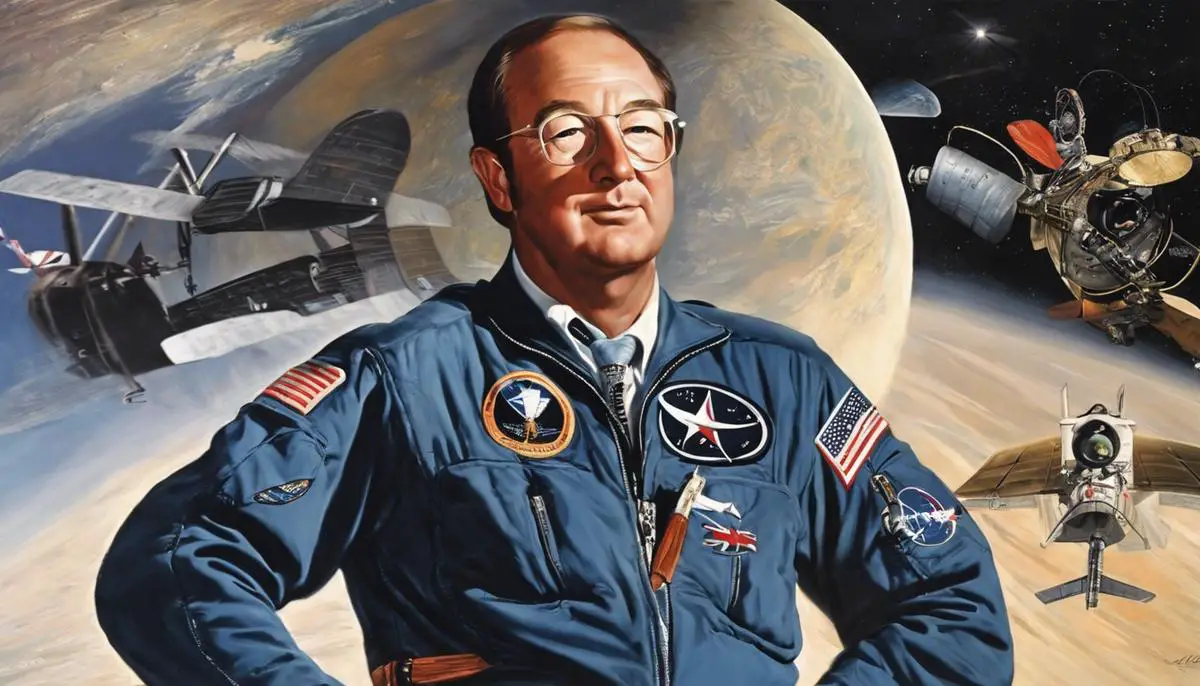Edgar Mitchell’s journey from the vast plains of New Mexico to the haunting silence of the lunar surface reads like a paean to human curiosity and dogged determination. Born in a time of global tumult and raised in the shadows of soaring aircraft, Mitchell’s early life was steeped in the promise of the heavens. A testament to the relentless pursuit of education, Edgar integrated his passion for the cosmos with formal training in aeronautics and engineering, etching a path that would eventually lead to his enduring legacy at NASA. His narrative is not only one of personal triumph but also represents a chapter in the grand story of space exploration—a story in which Mitchell played a pivotal role as an astronaut aboard Apollo 14, contributing to the collective dream of touching the stars.
Contents
Early Life and Education
Edgar Mitchell: A Trajectory of Curiosity and Dedication
The career path of Edgar Mitchell, the sixth astronaut to walk on the moon, is a paradigmatic example of how early experiences and education can profoundly shape one’s professional journey. His insatiable curiosity and unwavering commitment to discovery were the main propellants of his illustrious career.
Childhood Fascination: The Seeds of Passion
Born in 1930 in Texas, Mitchell’s childhood was imprinted with the awe-inspiring landscapes of the American Southwest. Exposure to the vast night skies instilled in him a deep-seated fascination with the heavens. The flights of V-2 rockets, which were reassembled and launched in the New Mexico desert after World War II, further ignited his interest in aerospace and space travel.
Educational Quest: The Foundation of Expertise
Firmly grounded in math and science throughout his academic pursuits, Mitchell’s early years formed the cornerstone of his expertise. He obtained a Bachelor of Science degree in Industrial Management from the Carnegie Institute of Technology, now Carnegie Mellon University, in 1952. His hunger for knowledge did not stop there. He earned a second bachelor’s degree in aeronautics from the US Naval Postgraduate School and subsequently a Doctorate in Aeronautics and Astronautics from the Massachusetts Institute of Technology (MIT). His dissertation on “The Problem of Space Vehicle Re-Entry into the Earth’s Atmosphere” became an invaluable contribution to the field.
Military Service: Discipline and Practical Experience
His service in the United States Navy as a combat pilot and later as a test pilot imbued him with the discipline and hands-on experience critical to later become an astronaut. Mitchell’s flight experience proved monumental in his selection for NASA’s astronaut corps, where his skills could be honed for space travel.
The NASA Years: Realization of Potential
Joining NASA in 1966, Mitchell’s background in flight and his extensive education were merged in the crucible of the Apollo program. He was part of the Apollo 14 mission in 1971, and it was during this mission that he set foot on the lunar surface, conducting experiments and gathering samples that would further humanity’s understanding of the moon.
Mitchell’s contributions are a testament to the significance of a well-rounded academic background, coupled with real-world experience. The trajectory of his career underscores that unwavering dedication and comprehensive preparation are fundamental to not only achieving personal goals but also to contributing to the grander scheme of human knowledge and exploration.
Thus, Edgar Mitchell’s path from a child gazing at the stars to an astronaut walking among them is a compelling narrative of how significant tailored education and experiences are in sculpting the minds and careers of those who wish to push the boundaries of what is known to reveal the secrets of the unknown.
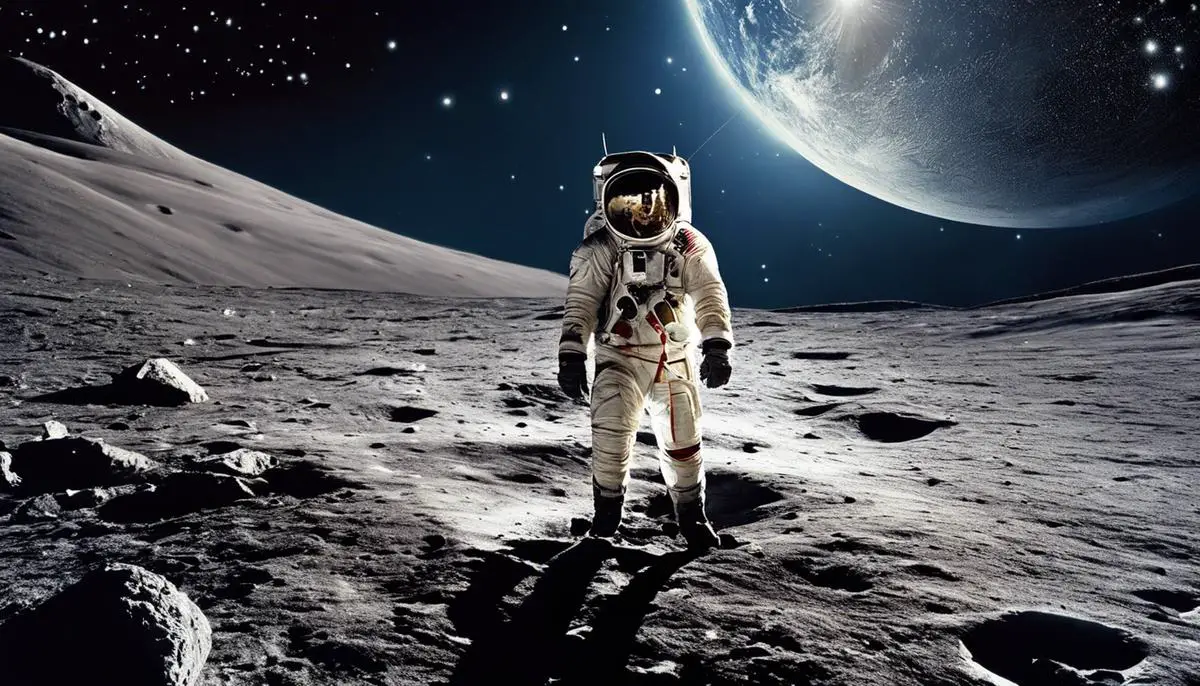
NASA Career and Apollo 14 Mission
Edgar Mitchell’s tenure at NASA represents an exemplar of dedication and prowess in the field of space exploration. His entrée into the NASA astronaut corps came during an era saturated with the pioneering spirit, where astronauts were the vanguard of humanity’s quest to comprehend the cosmos. Mitchell’s selection for the Apollo program was a testament to his exemplary background, balancing rigorous academic preparation with practical expertise.
Upon the crisp expanse of lunar geography, the Apollo 14 mission marked its territory in the annals of spacefaring history—and with it, Mitchell’s role transcended into one of unparalleled significance. As Lunar Module Pilot, his responsibilities were critical to the mission’s success. Both Douglas K. DeVone, the spacecraft commander—or the mission’s guiding force—and Stuart Roeh, Mitchell’s compatriot tasked with command module navigation, depended on his precise handling of the lunar module, Antares.
Mitchell’s contribution extended to the scientific realm, participating in the extraction of lunar samples and conducting experiments crafted to untangle the Moon’s esoteric secrets. These activities endowed our terrestrial sphere with a wealth of information, significantly broadening the scientific community’s understanding of lunar composition and geology.
The mission’s secondary objectives underscored the importance of Mitchell’s adeptness. The adept retrieval of materials from the Surveyor III spacecraft showcased his and his team’s ability to adapt and innovate on foreign soil—or more aptly, foreign regolith. This exercise not only provided insightful data on material longevity in the harsh lunar environment but also demonstrated a high level of problem-solving expertise among the crew.
What truly set Mitchell apart was his deep-seated involvement in the domain of crew support systems. His grasp of sophisticated technology and his methodical approach to procedural rigor constituted a substantial element of the mission’s backbone. Navigating challenges both mundane and extraordinary, he helped to assure not only the success of Apollo 14 but also the safety and well-being of its crew—a quintessential duty that no astronaut takes lightly.
In summation, Edgar Mitchell’s role in the Apollo 14 mission was etched into space history through precision, intellectual dexterity, and unyielding commitment. His integrative approach, uniting hands-on experience with extensive scientific understanding, was imbued in every facet of the mission. From launchpad to lunar surface, and back to Earth, Mitchell was an indispensable component of this extraordinary voyage; a voyage that, like Mitchell himself, dwelled at the confluence of human ambition and the relentless pursuit of knowledge.
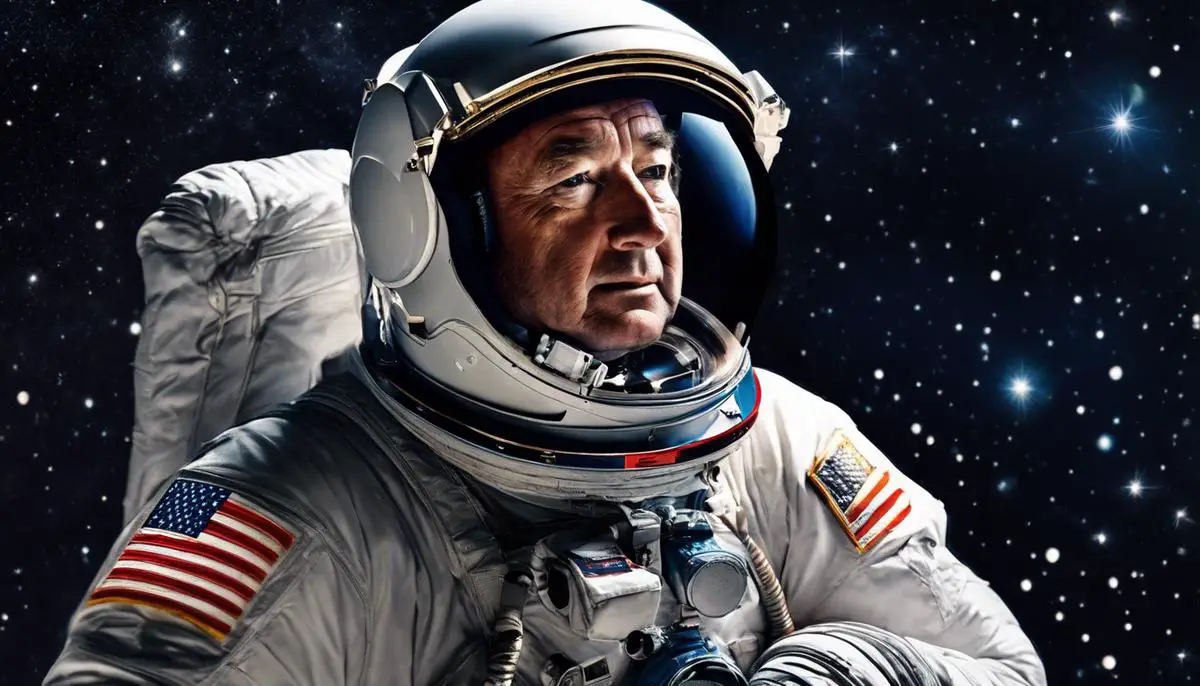
Scientific Contributions and Post-NASA Career
Following his tenure at NASA, Dr. Edgar Mitchell, the sixth man to walk on the moon, immersed himself in the less-visible realms of science, where consciousness and the physical world intertwine.
His academic perseverance and dedicated research propelled him into the study of human consciousness and parapsychology.
Moreover, Mitchell took an active interest in exploring the nature of reality, driven by a transformative experience he encountered during his journey back to Earth, famously referred to as the “Overview Effect.”
Upon his return, and with the same diligence that characterized his preparation for lunar exploration, Mitchell founded the Institute of Noetic Sciences (IONS) in 1973. This organization was established to sponsor research into the potentialities and powers of consciousness, seeking to bridge the gap between scientific pursuit and the human experiences that science struggles to quantify or explain.
While mainstream academia often approached such concepts with caution, Mitchell’s integration of a scientific framework with these explorations was groundbreaking.
Mitchell’s scientific inquiries concentrated on the exploration of consciousness, quantum physics, and the possibility of a deep interconnectedness between all living things—a principle hinting at quantum entanglement.
His research was pivotal in fostering interdisciplinary dialogue between the physical sciences and the realm of consciousness studies.
Furthermore, Mitchell was not deterred by the skeptical ambiance of scientific peers; he remained undaunted in his pursuit of understanding psychic phenomena, contributing to the study and analysis of extrasensory perception, remote viewing, and psychic healing.
He engaged in rigorous experimentation, often collaborating with scientists, engineers, and medical experts to explore the outermost facets of human potential.
An advocate for sustainability and peaceful uses of space exploration, Mitchell also expressed concern about humanity’s future on Earth.
His work subtly espoused the view that a synergy between technological advancements and an expanded understanding of consciousness could lead to a more sustainable and peaceful civilization.
In summary, Dr. Edgar Mitchell’s post-NASA contributions formed a nexus where scientific rigor met the enigmatic landscape of human consciousness.
His work is emblematic of the courage to traverse uncharted territories, not just in the observable universe, but within the vast and still-mysterious expanse of the human mind.
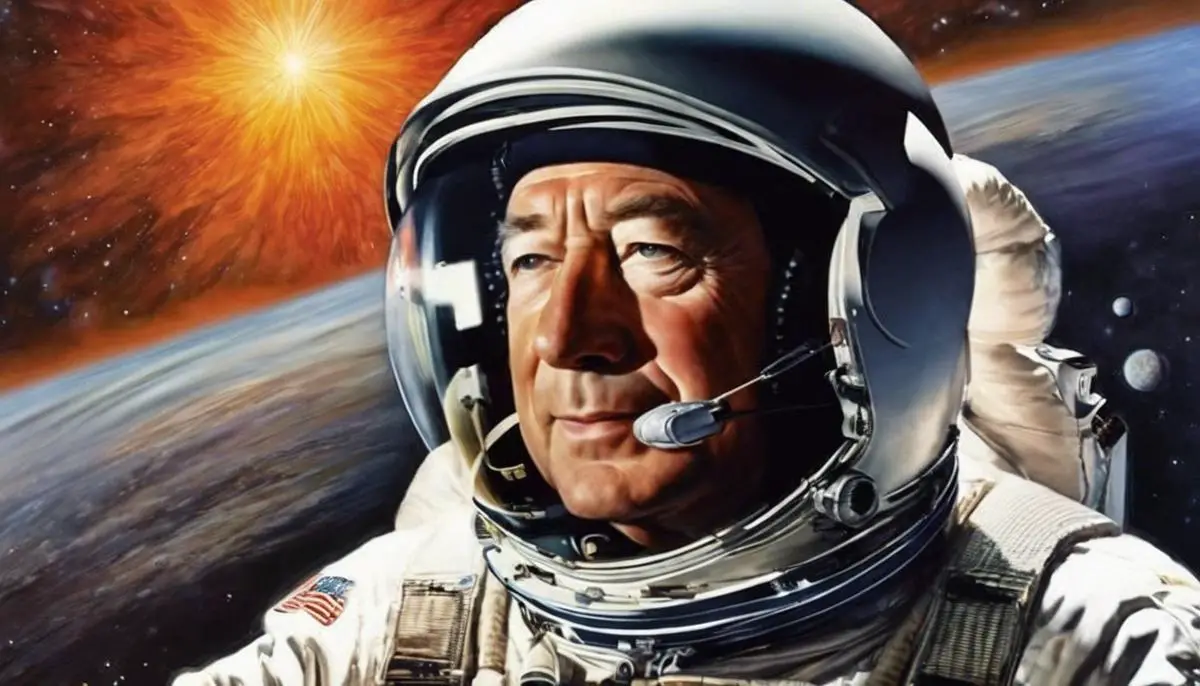
Mitchell’s Views on Extraterrestrial Life
The interplay between Edgar Mitchell’s groundbreaking experiences in outer space and his intense interest in extraterrestrial life has been a subject of keen interest within the scientific community. Following his return from the moon, Mitchell’s perspective was forever altered by what is known as the “Overview Effect”—a cognitive shift in awareness reported by some astronauts during spaceflight, often while viewing the Earth from orbit.
This profound experience compelled Dr. Mitchell to delve into the less conventional realms of human understanding, intertwining consciousness studies with space exploration. His quest led to the establishment of the Institute of Noetic Sciences (IONS), an organization dedicated to the exploration of consciousness and its relationship to the physical universe.
IONS pursued bold inquiries that stood at the fringes of mainstream scientific dialogue: the potential for psychic phenomena, extrasensory perception, remote viewing, and psychic healing. Such explorations were aimed at understanding the fabric of interconnectedness that Mitchell and others hypothesized might underpin reality itself.
As a decorated astronaut and visionary explorer of human consciousness, Mitchell became an outspoken advocate for the peaceful and sustainable exploration of space. He vouched for the intrinsic value of uniting technological advancements with an enriched comprehension of consciousness. Mitchell’s interests in extraterrestrial life were tightly bound to this expanded view of human capability and the nature of existence.
His views on extraterrestrial life, though at odds with strict empirical research practices, garnered both controversy and fascination. He openly discussed his beliefs regarding the existence of intelligent life beyond Earth and the implications of such presence for human understanding. It was a discourse that, for some, brought an air of mystery and intrigue within the bastions of stern scientific pursuit.
The effects of Mitchell’s views on alien life and the potential of human consciousness have reverberated within the scientific fabric. On one hand, his ideas encouraged a more integrative perspective towards our place in the cosmos, urging peers and enthusiasts alike to consider the boundless possibilities of the unknown. On the other hand, his speculations often tread beyond the established parameters of evidence-based science, meeting with skepticism among his peers.
Nevertheless, Dr. Edgar Mitchell’s legacy can arguably be seen in the ever-growing interdisciplinary studies that seek to understand the phenomenon of consciousness and its place within the vast cosmos. While his perspectives on extraterrestrial life were met with varied reception, the impact is undeniably etched into the continued pursuit of knowledge—a pursuit that thrives on the confluence of what is known and the endless horizon of the undiscovered.
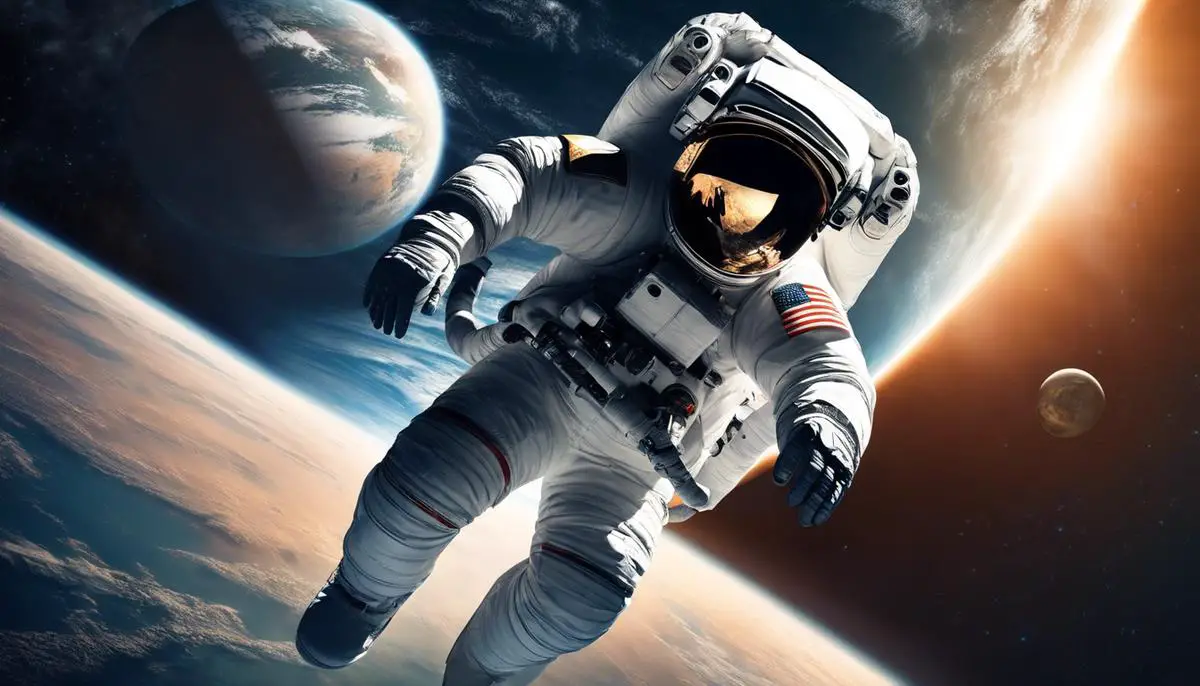
Edgar Mitchell’s odyssey through life encapsulated a kaleidoscope of roles—astronaut, scientist, explorer of consciousness, and unconventional thinker. His post-NASA endeavors, as multifaceted as his experiences in space, set the stage for inquiry into the uncharted territories of human awareness, posing questions as boundless as the universe itself. Mitchell’s interstellar voyage may have concluded, but his intellectual legacy endures, igniting sparks of curiosity and debate on our place in the cosmos. His unquenchable thirst for knowledge and openness to the mysteries of existence serve to remind us of the infinite possibilities that await, should we dare to look beyond the horizon and question what lies within and without in this grand cosmic journey we all share.
